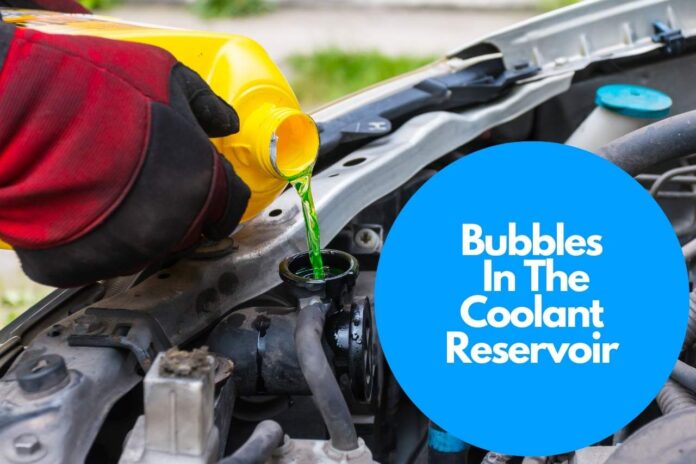For the engine to function correctly, automobiles rely on a liquid or air cooling system. However, the coolant system gets used in the majority of cars. This system depends on a compact network of pipes transporting coolant to the engine. This coolant gets kept in a rubber container known as the coolant reservoir and sent to engine parts. But eventually, the coolant reservoir can begin to boil, and you might be confused as to why. Bubbles in the coolant reservoir may occur for several reasons. While some might not require you to be a concern, others will demand that you act right now.
What Causes Bubbles In The Coolant Reservoir ?
The air causes bubbles to form in the coolant reservoir, but how? Many pressurized and sealed hose systems in automotive cooling systems allow coolant to travel around the engine. When air reaches this closed system, air pockets get formed. The coolant inside the reservoir begins to boil due to the air pocket obstructing the fluid flow, which causes an increase in temperature.
Reservoir bubbles can range in severity, and they can also occasionally be nothing to be concerned about. Certain behaviors will inevitably result in air siphoning into the cooling. In other instances, the cooling system’s air might indicate that a problematic component must get fixed. Let’s look at them now.
-
The Air pockets
Air pockets get created when coolant is drained and replaced in the coolant. The air pockets enlarge and are forced through into coolant when the automobile heats up while you are driving it. Air pockets occur as it enters this sealed system. Thus coolant is drawn from the reservoir to replenish the compressed air, resulting in bubbles. Although common, this may get prevented.
-
Faulty Radiator Cap
As a pressure seal, the radiator cap maintains high cooling system pressure, allowing coolant to flow into the tank. The coolant reservoir boils when this cap is damaged or changed with a non-compatible version, allowing air further into the cooling system.
After a lengthy drive, you can quickly tell whether your radiator is bubbling by looking for bubbles in the coolant reservoir.
-
Faulty Thermostat
The thermostat regulates how much coolant gets pumped into or out of the radiator. Here, a certain period is required for the thermostat to open and close. The radiator should get extended to allow the hot coolant from the engine to escape and cool. Then, keep your distance as the engine heats the coolant to begin the automobile.
The thermostat malfunctions when it fails to pop open at the appropriate periods. Uncontrolled airflow causes the coolant reservoir and radiators to start bubbling.
-
Ruptured Head Gasket
A blown head gasket is the most common reason for bubbles in the coolant reservoir. Any cylinder’s combustion gases can leak into the water jacket due to a faulty head gasket, allowing air to enter the cooling system through the cylinder head.
If bubbling appears when the engine starts, that is a sure sign that the gasket is leaking.
-
Developing Rust And Contamination
Metal radiators erode over time since they get constructed of metal. A radiator also accumulates contaminants when it isn’t frequently cleansed and supplied with the proper coolant.
Here, corrosion, filth, or other debris can obstruct the radiator’s tubes and impede the thermostat’s and water pump’s smooth performance. The coolant starts to boil under excessive heat, which causes the quick bubbles you observe in the cooling reservoir.
-
Malfunctioned Heater Control
The heater control allows hot coolant to get to the heater’s core, keeping the passenger area warm. Air enters the cooling system through a broken heater valve or a faulty heater hose connection, which leads the coolant inside the reservoir to boil.
-
Damaged Water Pump
The water pump flows through the coolant and antifreeze via the radiator’s cooling system, which cools down to the engine’s internal components through pipes and channels. Air enters the pumping input whenever the water pump is malfunctioning. Bubbles get created whenever the entrapped air reaches the radiator intake or coolant valve.
-
Leaky Hose In The Coolant Reservoir
The hose that connects the radiator to the coolant reservoir must always be secure and leak-free. A damaged or worn-out radiator pipe allows air to enter, boiling the coolant reservoir.
How To Deal With Bubbles In The Coolant Reservoir ?
Bubbles in the radiators can occasionally be caused by regular wear and tear, especially if the car has parked and the bubbles are present. The thermometer and other systems cease working once the vehicle stops, preventing the coolant from circulating.
You shouldn’t worry since your car won’t get harmed even if the coolant briefly boils due to this. If the coolant is bubbling, but the car is not overheating, it is normal and not a reason for alarm. The vehicle here only needs a few little repairs.
This can result from filthy coolant, insufficient coolant, or damaged radiator caps. It could be necessary to do the proper diagnostics to identify the reason. Replace the radiator cap if necessary. Before changing the coolant, add more or flush the old one.
Then take the wheel. If the air bubbles have ceased, a damaged radiator, contamination, or a shortage of coolant are the likely culprits. Consult a mechanic if bubbles continue to occur. Watch out for smoke and an overheated engine in addition to the bubbles. These are indications of an engine problem that must get rectified immediately.
Final Thought
To summarize, we require coolant to keep engines cool and avoid overheating. You must thus keep your engine’s coolant at the ideal amount. There are rumors that the reservoir contains bubbles. This will occur if there are indeed a lot of new presents. This can happen sometimes, and it’s also conceivable that a red flag indicates a more severe issue.
Related Articles on :
